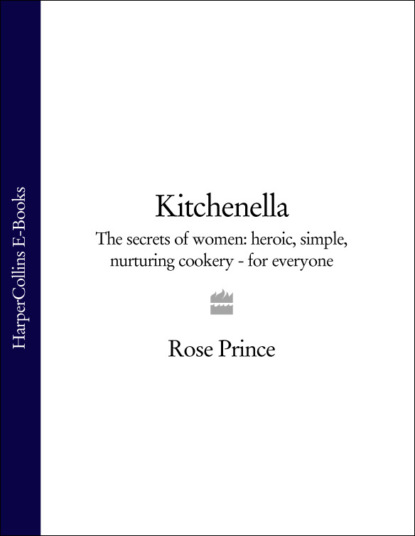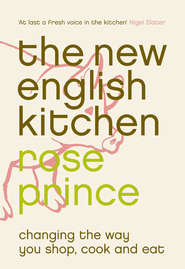По всем вопросам обращайтесь на: info@litportal.ru
(©) 2003-2024.
✖
Kitchenella: The secrets of women: heroic, simple, nurturing cookery - for everyone
Настройки чтения
Размер шрифта
Высота строк
Поля
Add one or more of the following (you can also eat this soup plain):
• Slices of ciabatta, baguette or other open-textured bread, fried until golden in olive oil
• Melted butter, with chopped garlic
• Red chilli, the seeds removed, then sliced
• Crisp sautéed bacon or pancetta, chopped
• Basil pesto sauce
• Black olive tapenade sauce
• Roasted red peppers
• Flakes of raw, undyed smoked haddock (they will cook in the hot soup)
Put the oil in a large pan and heat over a medium flame. Add the onions, garlic and fennel or other green vegetable and cook until transparent and fragrant, but not coloured. Add the beans with their liquid, then the water or stock. Bring to the boil and then cook for about 10 minutes until the beans and vegetables are soft. Transfer all to a food processor or liquidiser and blend until smooth. Taste and add salt if necessary. Add a good pinch of white pepper.
To serve, reheat until almost boiling. Add the yoghurt and heat until nearly boiling, then remove from the heat. Ladle into bowls and add one or two of the extra ‘outfits’ from the list.
Tomato and mascarpone cream (#ulink_75966db8-b7f3-5575-b5e2-35f3849c675e)
My father also remarried, when I was five. My stepmother Annie Lou, who at the time had no children, was suddenly faced with four children to feed for half of every holidays and little sympathy from her instant family. There was a kind of competence and reliability about her cooking, learned from Cordon Bleu recipe cards, Arabella Boxer’s First Slice Your Cookbook, and The Joy of Cooking, which we displaced children found reassuring. I am not sure how much joy Annie Lou found in cooking itself, but she saw it as a duty and shopped enthusiastically with the village butcher, and even grew vegetables. She did not make all the many different dishes my mother made, nor share my mother’s love of southern European food, but she had a few great staples that became ‘old friends’. You knew where you were in the week by what was on the table. If it was fish pie, it was Friday; cottage or shepherd’s pie was usually there on a Monday, the day after a magnificent roast, the joint bought from Mr Vigor in Woodborough. I have no complaints. On winter picnics at horsy events (not my favourite days as I did not share the family’s devotion to all things equine) she always filled flasks with very hot, Heinz tomato soup ‘let down’ with milk. I loved that stuff. Later, when making my own tomato soup with milk, I laughed to find its eventual flavour not unlike the one from the can. Adding fresh mascarpone cheese, however, takes the flavour of tomato soup to a new, richer level.
SERVES 4
4 tablespoons olive oil
2 garlic cloves, crushed with the back of a knife and peeled
1 x 400g/14oz can plum tomatoes, chopped
225g/8oz fresh cherry or other ripe tomatoes, roughly chopped
2 sprigs basil
1 dessertspoon sugar
200ml/7fl oz water or stock
250g/9oz mascarpone cheese
salt and black pepper
To serve: extra olive oil, extra basil leaves, bread such as baguette or ciabatta
Put the oil, garlic, canned tomatoes, fresh tomatoes and basil into a large pan and heat. When the mixture boils, cook for 10 minutes, then add the sugar and water or stock. Simmer for 20–30 minutes until sweet. Cool for a few minutes, then transfer to a liquidiser or food processor. Process until smooth and return to the pan. Stir in the mascarpone thoroughly and reheat. Do not allow to boil. Taste and add salt if necessary, then add pepper. Ladle into bowls, pour over a little more olive oil in a thin stream, then scatter over some extra basil leaves. Eat with slices of baguette or ciabatta (or other open-textured bread) fried until golden in olive oil.
The soups of French mothers
The French mother cooks, les mères, understood better than anyone the beauty of seasonal soups. These nineteenth- and twentieth-century cooks, who cooked in their famous restaurants as they would in their homes, were both experimental with their ideas and yet always down to earth, understanding the limits of their small kitchens and low budget. They made soup every day, with whatever produce had come into its glut season and had lowered in price. Soups were made quickly, preserving the green freshness of the vegetables. No one was given only a bowl of soup, the whole tureen would be brought to the table and ladled into diners’ bowls, often over something to make the dish more substantial: a piece of toasted bread and cheese, a poached egg, some steamed shellfish or braised bone marrow. When the bowl was clean, more would be offered. Imagine that in a restaurant today.
Garden ‘essences’ (#ulink_29113a9f-2c0e-53f4-827c-3449159562af)
These soups are made only with a single dominant vegetable, preferably without anything else other than water and butter, with maybe a few drops of cream at the end. They are very typical of the lunchtime soups offered by les mères in their restaurants. They have a light, quite thin texture, so put plenty of toast or fresh bread on the table. Or put another ingredient in the bowl, such as a poached egg, some grilled shards of bacon or some fresh goat’s cheese, spread on toasted bread. This method is ideal for the delicate sugary flavours of freshly picked seasonal vegetables. These soups must be eaten as soon as they have been liquidised, before they discolour or become starchy. The following soup is made with young broccoli, but there are various different vegetables this method is friendly to.
SERVES 4
6 walnut-sized lumps of butter
1 onion, chopped
450g/1lb fresh broccoli (in peak condition, no yellow flowers), chopped
1 litre/1¾ pints water, at boiling point
salt and white pepper
To serve: cream or crème fraiche (optional); a few cress leaves or ‘micro leaf’ herbs, pea shoots or even just tender parsley leaves; you can also serve over a poached egg or toast spread with fresh goat’s curd
Melt the butter and add the onion. Cook over a low heat for 2 minutes then add the water. Wait until you are on the point of sitting down to eat then add the broccoli. Cook for a further 4 minutes until the broccoli is just tender, then transfer to a food processor and liquidise until smooth. Taste and add salt if necessary, then add pepper.
Serve immediately, with a few blobs of crème fraiche, if you like, and some little leaves scattered over the top.
THE SAME ESSENCE SOUP – WITH ALTERNATIVE VEGETABLES
Replace the broccoli with:
• Watercress – use the upper leafy part of 3 bunches.
• Celery leaves – look for celery that has not been trimmed, and use about 4 handfuls of leaves, cooking them for about 5 minutes.
• Spinach – use 150ml/¼ pint less water with 450g/1lb spinach; if it is large-leaf spinach, this must be without the stalks.
• Fresh shelled peas, 450g/1lb. You can also make this with frozen petits pois but only simmer for 1 minute after adding the boiling water.
• Mange tout, 450g/1lb.
• Wild garlic, available in March/April – use 2 large handfuls, chopped, stringy stems removed.
• Sorrel – the lemon flavour of this leaf is beautiful, but be prepared for the leaves to quickly turn brown when cooked.
• Asparagus sprue or ‘kitchen asparagus’ – these are the thin stems; buy in mid-season when the glut brings prices down.
• Young nettles – available in March/April; you can pick them yourself using rubber gloves.
Lettuce and courgette ‘butter’ soup (#ulink_3843f14e-70c4-5230-928d-b872c5a35f74)









